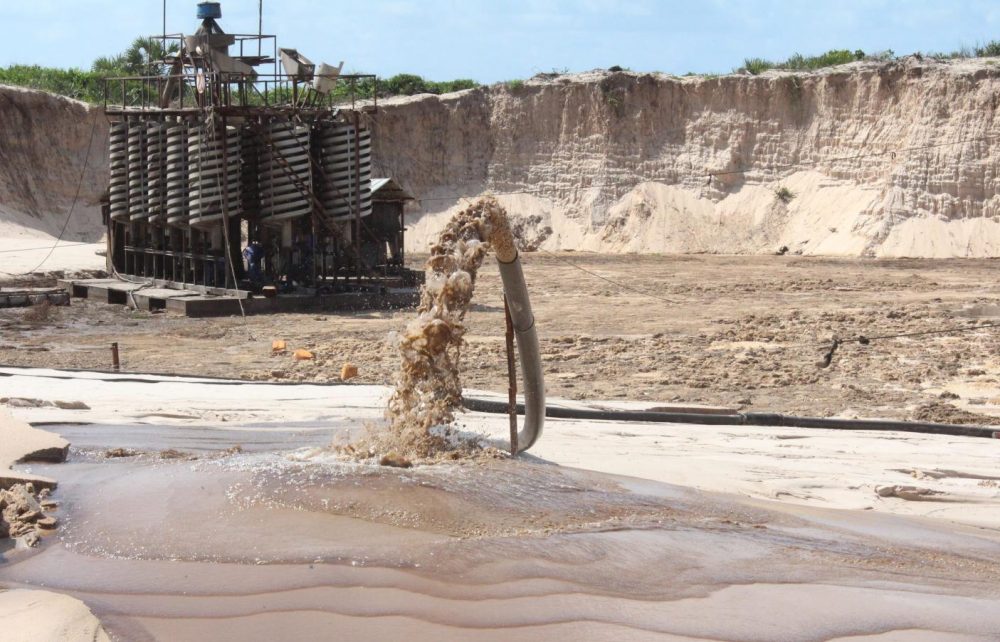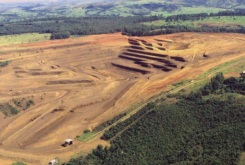China’s Dingsheng Minerals is on course to become the latest company to develop a heavy sands project in Mozambique. Minerals used in a wide range of industrial applications, such as zirconium, ilmenite and titanium, are extracted from heavy sands. Four big schemes have now been developed in the country, two of them by Chinese companies, and new projects are in the pipeline, but it is feared that one project contributed towards environmental damage in 2015.
Dingsheng Minerals is due to start production on its Chibuto heavy mineral sands project in Gaza Province, in the southwest of Mozambique, by the end of this year. Phase one covers 10,000 hectares and will have eventual processing capacity of 100,000 tonnes of sand a day but another 5,000 hectares could be added in Phase 2. Dingsheng expects to maintain production at the site for at least 15 years. A range of minerals will be produced, including ilmenite and rutile.
Dingsheng Minerals is 85% owned by China’s Anhui Foreign Economic Construction Group and 15% by Empresa Moçambicana de Exploração Mineira (EMEM). About 5,000 people will be employed when production begins, while investment costs on the project are put at US$400 million, although this presumably only covers mine development rather than the construction of more transport capacity. The company estimates that it has 6.5 billion tons of heavy sands containing 450 million tons of titanium concentrate and 20 million tons of zirconium concentrate.
There is still some doubt over how the minerals will be exported. Minerals are being transported 200 kilometres by truck to the dry bulk port of Matola in Maputo in the first instance. It was originally expected that a new spur line would be built connecting to the main railway to Maputo, allowing them to be shipped out from Matola. However, the Ministry of Mineral Resources and Energy now believes that a new port could be built at Chongoene in Gaza to serve the project and the possibility of transporting the minerals via barge down the River Limpopo to Chongoene has also been discussed.
UK-listed Kenmare Resources was the first company to develop a heavy sands project in Mozambique, starting production on its Moma mine – which yields both ilmenite and zircon – in 2007. Kenmare plans to ramp up production from 458,200 tonnes in the year to the end of June 2019 to 1.2 million tonnes a year by 2021 as output rises and new processing capacity is completed. Wet Concentrator Plant C is due to be completed by the end of this year.
The company made a post-tax profit of US$21.9 million in the first half of this year but a US$5.4 million fall in earnings because of the two big cyclones that affected shipments from Mozambique in March and April {link to the piece I wrote on the recovery from the cyclones}.
Kenmare says that it currently sells roughly equal amounts of ilmenite to Asia, Europe and North America but expects the Asian share to grow. At present, per capita Chinese consumption is just 30-50% of that of Western Europe or North America but the gap is closing.
Ilmenite has a wide range of uses, including producing titanium, which is used in paints and plastics. Titanium is often described as a ‘quality of life’ material, as its consumption increases in line with rising disposable income. Zirconium is already in high demand in China as it is used in the ceramics industry.
Flooding link
It is feared, however, that heavy sands operations caused coastal flooding at the village of Nagonha in Nampula Province. In 2011, Hainan Haiyu Mining Company began developing the Angoche project just 3 kilometres from the village on behalf of Africa Great Wall Mining Development Group. In February 2015, a flash flood destroyed 48 houses and damaged another 173 in Nagonha, leaving 290 people homeless.
Amnesty International reported that the heavy sands operations involved “bulldozing sand dunes, clearing vegetation and dumping mining waste over the wetland, burying two major lagoons and the waterways that connected them and the wetland to the sea”. This “interfered with the natural patterns of water flows in rainy seasons, and interfered with the ecosystem’s ability to offer ecological services to the people of Nagonha and surrounding settlements”, reported the NGO.
Two large lagoons that used to control flooding have disappeared, as 280,000 square metres of wetlands have been covered with sand mined by the company. Changing the topography of a coastline and altering the fragile relationship between the sea and sand dunes can have wide-ranging effects, so it is vital that thorough environmental assessments are undertaken prior to work beginning. The big question is whether the mine operations caused the flooding, or at least exacerbated its impact.
According to Amnesty, Haiyu did not complete the required environmental impact assessment and did not adequately monitor the impact of its operations. Haiyu has denied the claims, although it has offered limited compensation to the affected people. Campaigners are asking for much more money to be paid to them.
Further projects
Nevertheless, it looks certain that the number of commercial heavy sands projects in Mozambique will increase. Africa Great Wall already operates the Quelimane project in Zambézia Province, which came on stream in 2013, while MRG Metals holds exploration licences covering 631 square kilometres and has applied for another block of 360 square kilometres through its local offshoot Sofala Mining and Exploration.
In September, the Ministry of Mineral Resources and Energy awarded two 25 year concessions covering the Mutamba heavy mineral sands project to a joint venture of the UK’s Savannah Resources and Anglo-Australian mining giant Rio Tinto, subject to final approvals being granted. The two concessions include acreage in both Gaza and Inhambane provinces.
The joint venture was formed when Rio Tinto and Savannah decided that it made commercial sense to combine their adjacent planned projects. Savannah’s stake is due to increase from 20% to 35% once the pre-feasibility study has been completed and up to 51% if it completes the feasibility study, while Rio Tinto has the right to all output from the site.
Preliminary investment is already estimated at US$226 million. The investors estimate reserves on the two blocks, which are conveniently located close to the port of Inhambane, at 4.4 billion tonnes with 3.9% heavy minerals’ content. Savannah CEO David Archer said that it was one of the biggest untapped mineral sands deposits in the world. He said: “Given that the demand for global titanium feedstocks remains very strong, these mining concessions hold the potential as a significant global project within the sector.”
Archer added: “Given the demand for global titanium feedstock remains very strong, these mining concessions hold the potential as a significant global project within the sector.” The eastern coast of Africa is becoming a centre for heavy sands production, with projects developed from South Africa in the south to Kenya in the north. All are well placed to supply China and other Asian markets.
Official requirements
While most investment in the Mozambican mining industry has been targeted at the coal sector, other mining projects are now being developed, including for heavy sands but also limestone, iron ore, clay, gravel and marble. As in the coal industry, the progress on most projects is heavily reliant on the development of rail and port capacity to enable exports.
Investors require a series of permits, including a mining concession, an exploration licence and mineral processing and treatment licences. Companies active in the sector must be registered in the country, so foreign firms usually set up a local subsidiary, often with local minority partners. They must also demonstrate their technical and financial ability to undertake mining operations.
Exploration licences are valid for up to eight years, while concessions usually last for 25 years. The state has the automatic right to take a 5% equity stake without payment, while between 5% and 20% of the company’s capital must be listed on the Mozambique Stock Exchange within five years of starting production. It appears that the government now more often enforces existing regulations on foreign companies training Mozambicans to work alongside the skilled workers that they recruit for mining projects in the country.
According to local law firm SAL and Caldeira Advogados, mining titleholders must:
- Undertake mining activities in accordance with the applicable legislation and best mining, social and environmental practices;
- Respect local communities and contribute to their socio-cultural preservation by implementing corporate social responsibility projects;
- Compensate land users for damage caused to their land or property as a result of the mining activity;
- Restore the environment in the area subject to the mining activity and repair any damage caused by it;
- Communicate the discovery of minerals to the government in accordance with the applicable regulations and before making any public announcement;
- Insure the site and infrastructure in accordance with the applicable legislation in relation to the following risks: damage to the site and infrastructure; liability towards third parties; and work accidents of the personnel.
- Sell mineral products in Mozambique for industrial development whenever necessary.




